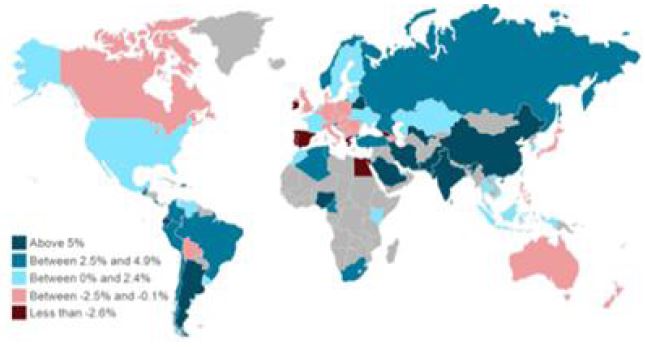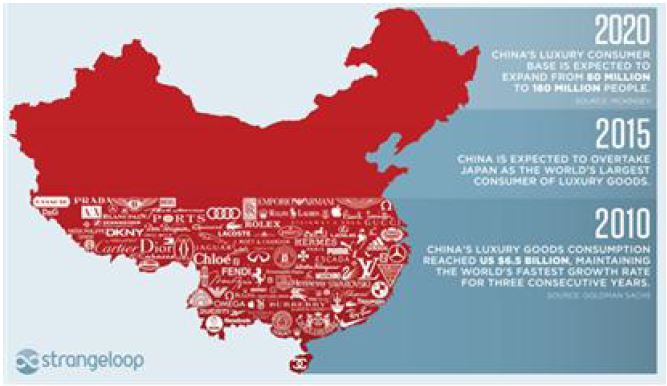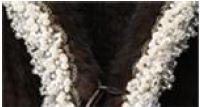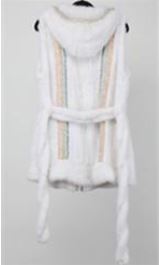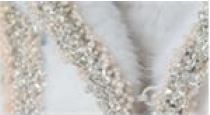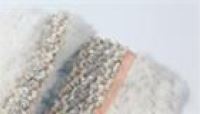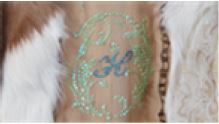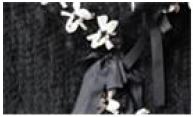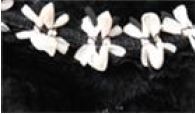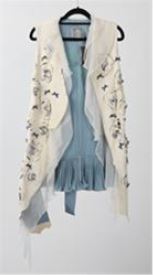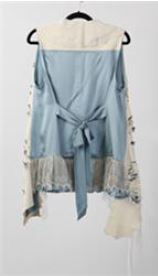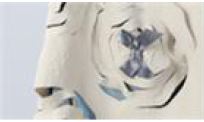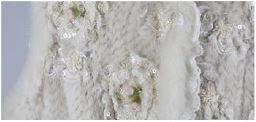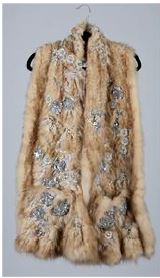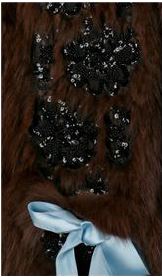
Development of Fashion Faux Fur Using 3-Dimensional Embroidery Technique for Russian, Chinese Premium Markets
This journal was supported by National Research Foundation of Korea Grant Funded by the Korean Government(MEST)
이 학술지는 2013년도 정부재원(교육과학기술부)으로 한국연구재단의 지원을 받아 출판되었음
Background Despite of the economic downturn in developed countries, the demands of emerging markets are expected to grow continuously with the increase of consumers' demands for luxury fashion products in global emerging markets. In particular, it is as foreseen that the purchasing power of wealthy will be strengthened despite the protracted downturn, and the consumption of the wealthy in emerging countries will be the driving force of high-end markets. Accordingly, the development of premium fashion product designs can be said to be the strategic gateway to achieving success in global markets. Thus, this study focuses on the development of design products for the emerging fashion markets and the world's two largest consumers of fur - Russia and China.
Methods In this study, literature reviews were conducted in order to identify the trends of target countries and global fashion fur markets. The primary literature reviews were based on the study of dissertations focused on the topic of fur fashion and fur markets. Secondary studies on global markets and trends were based on the analysis of market reports by KOTRA and other domestic and foreign economic research institutes and researchers. Also, in-depth interviews and surveys for local buyers were carried out along with an analytical review of the world's top four fashion week collections.
Thus, based on the findings of the studies, target markets and the direction of item development were selected for design results. Based on the results above, the target market and target consumer were set, the items to be developed and direction were determined, and design development was then conducted.
Results Based on the findings of the primary and secondary literature reviews, it was found that Russia is one of the largest emerging fashion markets known as the bridgehead for advancing into Eastern Europe where Western apparel makers and buyers gather despite the global recession. It was also found that China is the world's largest fur importer. The purchasing power of these emerging consumers is beyond imagination and is not affected by economic situations. Thus, the ultimate goal of the study was to develop differentiated premium fashion faux fur products which can be easily exported. Aiming to preempt the China and Hong Kong market, the world's top fur market, and advance into Russia, the bridgehead of the Eastern European market and the world's second-largest fur market, a total of 10 kinds (eight vests, two mufflers)of luxury fashion faux fur products using 3-dimensional embroidery techniques were developed.
Conclusion Fashion faux fur is considered as a "Blue Ocean" in the fashion industry and therefore, if design development and production lead to export and the quantity is expanded, it is expected not only to create jobs in the related industry but to be the best breakthrough to end the recent stagnation in Korea's fashion industry. Through this study, the revitalization and improvement of future research and design strategies that can cope with the ever-changing global fur-apparel markets are expected.
초록
연구배경 선진국의 경제 침체에도 불구하고 신흥시장 수요는 지속 증가할 것으로 전망되고 있고 글로벌 신흥국들을 중심으로 한 소비자들의 고급 패션제품 수요 증가는 가히 폭발적이다. 특히, 경기불황이 장기화 되어도 수퍼리치(Super rich)의 구매력은 더욱 강화될 것이며, 특히 신흥국 부유층의 소비가 하이엔드 시장 성장의 원동력이 될 것으로 예견됨에 따라, 주요 신흥국 공략을 위한 프리미엄급 패션제품 디자인 개발을 강화하는 것은 세계시장 진출성공의 관문이라 할 수 있겠다. 이에 본 논문에서는, 패션시장의 떠오르는 이머징 마켓이며, 전 세계 1, 2위의 모피소비국인 러시아와 중국을 중심으로 한 수출용 디자인제품 개발을 진행하였다.
연구방법 본 연구에서는 먼저 수출 대상국과 글로벌 패션모피 시장 동향을 이해하고자 문헌조사를 실시하였다. 1차 문헌조사는 주로, 모피패션, 모피 시장 분석에 관한 주제를 다룬 논문을 바탕으로 기본 연구를 진행하였다. 다음으로 글로벌 시장 정보와 트렌드는 KOTRA와 국내외 경제연구소, 연구원을 중심으로 한 시장보고서를 중심으로 분석하였다. 다음 단계에서는 현지 바이어들과의 인터뷰와 설문조사, 세계 4대 패션위크 컬렉션 자료 분석을 실시하였다. 이를 바탕으로 하여 목표시장 및 타겟을 설정하고 개발 아이템과 방향을 정한 후, 디자인 개발을 진행하였다.
연구결과 1,2차 문헌조사 결과, 러시아는 글로벌 불황에도 불구하고 서구 어패럴 메이커와 바이어가 몰려드는 동유럽 진출의 교두보인 패션 이머징 마켓이며 중국은 세계최대 모피 수입국으로 이들 신흥 소비국은 상상을 초월하는 구매력을 가짐과 동시에 경기에 민감하지 않음을 알 수 있었다.이에 수출에 용이한 차별화된 프리미엄급 패션 인조모피 제품 개발을 최종 목표로 삼았다. 세계 1위 모피시장인 중국 및 홍콩 시장을 선점하고, 동유럽 시장의 교두보이며 세계 2위의 모피시장인 러시아에 진입하는 것을 목표로 하여, 3D 입체자수 기법이 가미된 럭셔리 패션 인조모피 제품 총 10종(vest류 8종, 머플러류 2종)을 개발하였다.
결론 패션 인조모피는 패션분야의 블루오션이라고 할 수 있으므로 디자인 개발과 제작이 수출까지 연결되고 그 물량이 확대가 된다면 관련 동종 업계의 고용창출은 물론이고 최근 침체기에 있는 한국의 패션업계에 최상의 돌파구가 될 것이라고 예상한다. 본 연구를 통하여, 변화하는 글로벌 모피의류 시장 수요에 적극적으로 대응하는 유용한 디자인 및 전략 연구가 활성화되기를 기대한다.
Keywords:
3D Embroidery, Russia, China, Faux Fur, Fashion Fur, Niche Market, 3D 입체자수, 러시아, 중국, 인조 모피, 패션 모피, 니치 마켓1. Background and purpose
Once known as the symbol of power and wealth, fur is quickly changing under the title of 'diversity of fashion items', despite of the current global economic downturn. Recognized as a second-rate product of natural fur, faux fur has been undervalued and treated as a low-grade product. However, in recent global fashion collections, faux fur has been frequently appearing as differentiated designs or in combination with other various materials.
In particular, new interest in faux fur is sparking as major global luxury brands actively present the characteristics of faux fur through various fashion product designs. Above all, beautiful and colorful faux fur fashion is the latest trend in the fashion industry led by global luxury brands such as Fendi, Chanel, and Prada and irreversible social flow leading to eco, organic, and respect for life. In addition, the development of various materials and fabrication methods has improved traditional fur style, contributing to a more new and creative design of fashion fur. Thus, according to the global luxury fashion market trends that are rearranged based on fur apparel collection markets, consumption patterns, and emerging countries, the effort for developing premium faux fur fashion products satisfying preferences and buying patterns of global consumers are required. At the same time, new marketing strategies that can properly connect consumers and products need to be established.
However, most researches and studies related to fur apparels have been centered around consumption behaviour or growth strategies based on economic reports instead of the apparel design itself. Most studies on the field of fur are economic reports only focusing on consumption behaviour or fur industry-wide growth strategies instead of fur clothing itself.
Thus, the primary purpose of the this study is to develop differentiated faux fur fashion products optimized for export. First, we tried to understand the trends of the markets of export target countries and global fashion fur markets. To this end, we conducted primary research based on literature review on fur and fur fashion, fur market analysis. And then, we carried out secondary research for global market information and trends based on the market reports of Korea Trade-Investment Promotion Agency(KOTRA), Samsung Economic Research Institute(SERI), and LG Economic Research Institute(LGERI), surveys and in-depth interviews with local buyers and review of the world's top four fashion week collections.
Based on the above findings, ten fashion faux fur products(eight vests and two mufflers) were designed and developed with application of 3-dimensional embroidery techniques for target countries, China and Russia, idealized for exporting of faux fur fashion products. Selecting China and Russia determined as optimized for export of premium faux fur fashion products as the target markets, we developed a total of 10 designs(eight vests, two mufflers) of new fashion faux fur products combining a variety of materials of 3-dimensional embroidery technique with faux fur.
2. Market status of global emerging countries
According to KOTRA'S Global Window Foreign Market Information(2012), while the consumer markets of emerging countries continued to grow due to the income growth in 2011, the growth of consumption markets in developed countries became stagnant due to the financial crisis in 2008/2009 and 2011. The consumption markets in emerging countries are expected to grow at a rate of 4.6%, similar to the year 2010, but those in developed countries have barely recorded plus growth or negative growth. As the demand of emerging markets is expected to grow despite of the economic slowdown in developed countries, expansion into major emerging economies is needed to be strengthened. In particular, as upper-class consumers of emerging countries are expected to lead the future trends of the world's consumption markets, targeting such consumers is an essential strategy.
2.1. Polarization of the world's consumption markets
In the report, 'Take advantage of polarization of the world's consumption markets in 2012', KOTRA(2012) forecasted that the emerging markets will continue their prosperity while upper-class consumers will be the leading contributors of the development and proposed the strategy of taking the polarization phenomenon of emerging countries as a chance of entering into global markets.
Despite the rapid economic growth and average income growth, polarization of wealth in the emerging countries still remains a chronic problem.
According to KOTRA(2012), increasing demand for premium, up-to-date products around such countries' upper-class consumers causes global companies to transfer their sales target from developing countries to emerging countries.
Also, the purchasing power of the 'Super Rich' is expected to be strengthened even in the global economic downturn, while the consumption of the wealthy in emerging countries will be the driving force of high-end markets. The key to success in entering global markets in the future depends on the entry into the emerging markets. For example, consumers of big cities such as intensively developed East Coast region of China, New Delhi and Mumbai of India are expected to contribute to the enhancement of consumption markets while the middle-class population in India is expected to reach six billion by 2025 and therefore, the key to success in entering global markets in the future depends on the entry into the emerging markets.
Also, KOTRA(2012) stated that luxury clothing, accessories, and electronic products will be the center of consumption of upper-class consumers in emerging countries while luxury cars, yachts, private planes, and luxury travel products are promising commodities.
2.2. Fashion markets in China and Russia
New York, London, Milan, and Paris are evaluated as the leading capitals of the world's fashion trends; however, experts consider Moscow in Russia and China as ‘The future of reviving fashion industry.’
According to the Moscow trade department of KOTRA(KBC)(2012), Russian fashion market is growing rapidly each year. As of 2010, the scale of Russian fashion market has reached approximately 60 billion dollars with clothing import rate of 9.2 billion dollars; however, given that 85% is grey clearance via bordering areas, import is expected to be in a much larger scale. In addition, as grey clearances currently committed by Russian clothing importers are improved and the distribution system becomes more transparent, overall business environment along with consumer welfare is expected to be improved. In particular, considering a population of 140 million and the winter season from October to May, the growth potential of the fashion market is evaluated as endless if economic conditions are supported. Currently, Russian apparel market is also inactive due to the global downturn; however, along with economic recovery, Russian fashion market is anticipated to become the most prosperous market in the fashion industry. Particularly, Russia, which achieved rapid economic growth based on abundant natural resources, turned its attention to culture and fashion.
On the other hand, AT Kearney presented Russia as the world's tenth largest retail market in 2010, emphasizing Russia as the largest distributor in Eastern Europe's retail markets. Also, in 2012, Russian fashion market was ranked as the world's ninth largest market.
Moreover, according to the '2013 Hurun Report', called as Chinese [Forbes], by Chinese Hurun Research Institute, Moscow is considered a city with the most population of the world's billionaires. Of 1,453 billionaires with assets greater than one billion, 76 people live in Moscow. In addition to Moscow, consumption growth of luxury products around luxurious vacation spots such as Sochi, and Black Sea resorts are growing rapidly.
After the 2000's, due to the rapid inflow of oil dollars in Russia, there has been a dramatic increase in conglomerates and net income of the middle class. Especially, Russian luxury markets targeting the rich in Moscow have rapidly developed. By the end of 2010, Russians with more than 1 billion dollars of assets have increased by 48%(114 people) compared with the previous year. Such increase in assets is evaluated as the result of crude oil and rise in stock prices, while the expansion of consumption expenditures is expected to have a positive effect on the Russia luxury industry. Given that luxury products account for 10% of current Russia's distribution sales and the annual growth rate of 17% in Russia's 2,400 dollar-scaled luxury market, the high value-added fashion industries in Russia can be said to have a bright future (KOTRA, 2012).
According to Amiko, the consulting company, the production of Russian fur jacket and coat has increased to 92,220 pairs in 2010, developing 31.1% compared to 2009. This production rate is inferior to 137,000 pairs produced in the year 2006, but has earned a significant level of growth compared to 70,000 pairs produced in the year 2009 (KOTRA, 2011). This is fewer than 137,000 pairs produced in 2006 but the figure increased significantly compared to 70,000 pairs in 2009 (KOTRA, 2011).
Italian fur designer Simonetta Ravizza anticipated a bright future for the Russian fur market. With the opening of boutique store in Tsum, the world's fourth largest luxury department store in Moscow, Ravizza commented that Moscow's wealthy shoppers are turning back to the products of the world's top designers as the economy and consumption demand recover.
According to World Federation of Overseas Korean Traders Associations(World-OKTA)(2011), 79% of Russians possess at least two pairs of famous foreign fashion brands while only 8% of them possess Russian designer brands.1) RBC analyzed that Russians tend to rate its light industry low and prefer foreign brands.2)
According to the Chinese Trends report by KOTRA(2006), clothing consumption in China shows the characteristics of diversification, fashionization, and individualization. Products of famous foreign brands and foreign investment companies get an absolute majority in mid- and high- priced fashion markets around big cities, and the number of Chinese unique brands is very small. That is, more than a half of consumers prefer famous foreign brands while only 16.7% of them prefer Chinese brands.
Of recent Korea-China trade conditions, the 'Han-Ryu'(Korean wave) is the most notable phenomenon. Starting with the 1988 Olympic Games in Seoul, awareness on Korea has been increased by the 2002 World Cup, while the increase in Korea's investment and boom of Korean language department in Chinese universities along with the popularization of 'Han-Ryu' around entertainment industries have enhanced the images of Korean products.
On the other hand, due to the rapid growth of Chinese millionaires, Hong- Kong, a typical subtropical country, has emerged as the world's largest hub of fur products. According to one fur seller (Everest), buyers of fur in China are estimated to reach about 1-2 million people. Especially, as upper-class female consumers highly prefer fur, it is estimated that around 300 thousand coats are sold annually in Harbin (KOTRA, 2011).
Even at the downturn of overseas markets in 2010, China's consumer markets have grown at a development rate of 18%, while the demand for luxury items including fur is expected to increase more.
Asia's largest fur exhibition, the Hong Kong International Fur & Fashion Fair(organized by Hong Kong Fur Federation), is held in China with about 270 participating companies from 16 different countries(Argentina, Canada, China, Finland, Germany, Greece, Italy, Korea, Namibia, Russia, Spain, Turkey, UAE, England, USA, etc.), while business order was estimated to be around 1.3 million dollars.
The import of fur and raw hides in China and Spain accounted for 30% proportion, but with a dramatic growth rate from 35.2% in 2001 to 78.1% in 2010, China was positioned as the exclusive market of fur import. For the last 10 years, China has accounted for the overwhelming proportion of more than 50% in the import of fur clothing including faux fur. Fur import in Hong Kong has grown rapidly more than 3 times from 1.6 million dollars in 2000 to 4.6 million dollars in 2009.
Moreover, through Closer Economic Partnership Arrangement(CEPA) guaranteeing duty-free benefits on products from Hong Kong when sold in China from 2006, China and Hong Kong have emerged as the hub of fur trade, handling 70~80% of the world's fur products. In addition, handling 70% of pre-processed fur and 80% of processed fur in the current global fur markets, China was crowned as the world's largest fur market, beating Russia with the population of 1.6 million which has been ranked as No.1 since 2006 .
The characteristics of Chinese and Russian fashion markets based on the above analysis can be summarized as follows.
3. Status and Trends of Global Fashion Fur Market
According to Chung, S(2011), with the improvement of consumers' standard of living, fur clothing has been considered a fashion item based on personal tastes and preferences, while the appearance of practical designs has grown interest among young consumers. Like this, fur clothing has become not only a symbol of wealth and prosperity but also a way of self-expression.
With the development of the fur industry in fashion-developed countries including Italy, market perception itself on fur products has changed from status symbol to the concept of accessories.
Thus, fur has gradually become one of seasonal accessories from traditional concept of investment for long-term clothing. Now, the concept of fur has changed from “investment for long-term clothing” to accessories that can be changed “almost” every season. Also, it is easy to find statistics showing that consumer age groups of fur have been very lowered around the world, showing that fur is significantly appealing to young consumers not limited only to "madams".
Globally, fur can be divided as natural fur and faux fur. More than 100 different kinds of animals are used for natural fur. While carnivorous animals such as fox, mink, sable, etc. are considered premium fur, rodents such as chinchilla and hamsters, and pinniped such as sea lions, seals, and beavers are also used for fur manufacturing. Natural fur is highly expensive due to its limited raw material supply, complicated manufacturing process, and requires special care but these problems can be easily solved by using faux fur.
Created with synthetic fibers attached to a backing, the shape and the type of faux fur varies according to various techniques of fiber attachments. The texture and natural beauty of faux fur were somewhat inferior, but today's fake fur is nearly indistinguishable from natural fur due to the development of processing technology. As the advancement of faux fur manufacturing technology was coupled with the wildlife conservation movement, faux fur began to appear in famous foreign brands.
Most domestic fur brands focus on natural fur materials while fur consumers place more value on the quality of the product rather than the brand or design as design itself is more important in the faux fur markets.
Karl Lagerfeld, the creative director of Chanel and Fendi, is leading the luxury fur fashion around the world, consistently presenting extravagant fur coats in Fendi winter collections. In the Chanel 2010 F/W collection, he presented a variety of faux fur fashion and accessories inspired by melting iceberg and polar bears of the Arctic.
Lagerfeld has been presenting fashionable fur designs and a wide variety of applications of materials through various fabrication methods of natural and faux fur in annual Fendi collections. By recruiting Karl Lagerfeld in 1965, Fendi transformed bold and heavy fur designs into light, soft, and fashionable fur products.
In the F/W 2008 collection, Lagerfeld presented fur designs gilded with 24K gold. The gold shimmers in the fur were created with an advanced technology in which the fur is put into a molecular chamber that deposits gold particles onto the pelt, allowing it to remain silky.
In addition, many other global luxury brands have presented various faux fur products. A lifelong vegetarian and a supporter of PETA(People for the Ethical Treatment of Animals), designer Stella McCartney created fur silhouettes and textures by picking woven fabrics and combining other creative materials such as carpets and towels.
Designer Miuccia Prada of Prada presented a mohair collection created by gluing faux fur onto pieces of backing while designers Domenico Dolce and Stefano Gabbana of Dolce & Gabbana presented a variety of synthetic lamb fur vests in their runway collections.
3.1. Trends of fur design
Composed of elements such as materials, silhouette, and color, domestic and foreign fur designs show no significant differences in designs of coat, jacket, and vest.
Recently, with the change in consumer's lifestyle and preferences, the demands for fashionable fur have increased with the introduction of new fur designs using various fabrication methods such as let-out, skin-on-skin, corduroy, chevron, and hair-up.
In addition to outers such as jacket and coat, highly applicable items such as vest, knit, cape, muffler, and other accessories are becoming more diverse.
Fur vests were considered one of the representative fashion items of the last season and popularized for its casuality and lightness, while variations in designs of simple 'A' line, slim 'H' line, short sleeves, collarless and round necks have been released in current markets.
3.2. Trends of fur materials
While 'full mink coat' designs made by only one fur material were dominant in the past, fur products in combination of various fabric materials such as wool and cashmere are gaining popularity in the recent years.

(From left to right) 2010 F/W Hermes, 2011 F/W Sonia Rykiel, Burberry Prorsum, Gianfranco Ferre collection - a mix and match of fur and other various materials<source: www.style.com>
Also, the demand for fur products among young consumers has been dramatically increasing due to the introduction of new fur designs such as attaching leather and suede pieces to sliced strips of fur materials, creating more modern fur products. Moreover, in addition to short but suppled mink fur, long and soft fur materials such as fox, raccoon, mouton, sheard lamb, sable, and beaver have been gaining popularity. Yet, as mink fur still remains the hottest item of all fur products, the range of colors has increased along with the advancement of the processing method of making the material as smooth as silk.
3.3. Trends of fur trimmings
In order to emphasize the creativity of designs, trimmings such as embroidery, beading, and dyeing are used for recent fur products.
The most frequently used trimming technique is the embroidery method, but most fur products are machine-embroidered on top of mixtures of materials such as leather, knit, suede, and fur. Bead decorations made by pearls and artificial gems are also commonly used trimmings in fur products, but are only available in some fur designs. In addition to embroidery, beads trimming, and edge trimming using knitted patchworks, woven fabrics and fur dyes are also used in faux fur to express its unique color.
As shown above, designs of fur products have evolved through the application of various trimmings such as embroideries, bead trimmings, and color dyes; however, such fur designs are not popularized yet and are only presented as a piece of work in runway collections.
4. Design Proposal
4.1. Target market
In this study, we set Hong Kong as the starting point and selected Chinese and Russian markets as the target niche market for taking advantage of the global polarization as the opportunity for Korea to enter into the global luxury fur fashion export markets.
The purpose of the study is to preempt Chinese and Hong Kong fur markets and advance into Russian fur markets through the development of fashion faux fur design for VVIP women consumers of age 28~40 living in regions.
4.2. Direction of design
In this study, the development direction to differentiate fashion faux fur design is to add feminine details and decorative characteristics by combining ‘fashion fur’ with ‘3-dimensional embroidery’.
'Fashion fur' described in this study is defined as fashionable and trendy fur design that is distinctive from existing fur products through the application of 3-dimensional embroideries of beads, ribbons, stitches, and patchworks, and combination of other various materials such as silk, lace, leather, and suede in natural fur and faux fur.
Also, 3-dimensional embroidery technique is a frequently used method in premium luxury brands for its distinctiveness, qualitative improvement, and higher value-added designs. That is, handicraft decoration technique increasing the value of fashion products refers to the advanced technique for the development of 3-dimensional motifs created from exclusive materials such as rhinestones, sequins, beads, and ribbons, distinctive from existing embroidery techniques such as embossing, 3D embroidery, and needlework.
4.3. Price
Due to the global recession as of 2014, products were developed and priced based on the high price of faux fur products. Thus, vests were priced as a FOB(Free On Board)3) price of 2.5 million won(KRW) with muffles as 1 million won.
4.4. Materials
Since female consumers buying expensive products are especially sensitive about the material of the product, components to be applied in 3-dimensional embroideries such as laces, seashells, metals, and plastic beads were imported from France while crystals and pearls from Swarovski in Australia.
So we tried to use Country of Origin effect in marketing through the use of the best materials in the world.
5. Design Development
5.1. Combination of faux fur with 3-dimensional embroidery
First, 3-dimensional embroideries were applied to various faux fur such as AH(Animal Hair) that is similar to natural fur, DDF(Dope Dyed Fiber) that is similar to mink, DD(Discharged Dye) that is bleached on the end of the fiber, Jacquard, also known as pattern-embossed fabric, Mogul that is crinkled with steam and pressure, Printing, and Lamb Tumbling that duplicates the wool textures.
The process of 3-dimensional embroidery was carried out through the following five steps.
1. Sketching on tracing paper, Khaka
2. Punching of tracing paper (actual fabric miniscule pin holes)
3. Pinning of fur hair in one direction
4. Printing
5. Hand Embroidery
6. Quality Control
5.2. Style
Since the test products made as a result of the following study are to be exported into foreign markets, loose-fit vests and mufflers were developed in free sizes. As high-quality products are produced with scarcity, all designs were 100% handmade in Korea with advanced couture sewing techniques to refrain from mass production.
5.3. Buyer Survey and Consultation
Each product was sequentially sent to three Russian buyers, one Hong Kong buyer, and two Chinese buyers to rate for the quality of 3-dimensional embroideries, the design, color, and market potentiality. Final prototypes were completed based on the feedback and comments of individual buyers.
6. Design
[Product 1]
• Concept: This sleeveless vest was crafted with Swarovski pearls and shell beadings to maximize the slim line of the vest pattern.
• Material(Faux Fur) : DDF(Dope Dyed Fiber)
• Material(Details) : Swarovski pearls, recycled plastic, seashells
• Launch date : September, 2014
• Buyer ratings :
 / Order complete
/ Order complete
[Product 2]
• Concept : This vest design was crafted with 3-dimensional embroideries of Swarovski pearls, seashells, and glass beads that punctuate the slim silhouette of the vest pattern.
• Material(Faux Fur) : DDF(Dope Dyed Fiber)
• Material(Details) : Swarovski pearls, silk ribbons, seashells, glass beads
• Launch date : September, 2014
• Buyer ratings :
 / Order Complete
/ Order Complete
[Product 3]
• Concept: This detachable vest/jacket contains sparkling sequins and brocades crafted from fine Swarovski beads and sequins.
• Material(Faux Fur) : DD(Discharged Dye)
• Material(Details) : Laces, sequins, brocade
• Launch date : September, 2014
• Buyer ratings :
 / Order complete
/ Order complete
[Product 4]
• Concept: The vest is covered with semi-sheer layer of lace topped with 14k gold threads and sequin embroideries.
• Material(Faux Fur) : AH(Animal Hair)
• Material(Details) : 3 kinds of 14k gold threads, sequins, laces
• Launch date : September, 2014
• Buyer ratings :
 / Order complete
/ Order complete
[Product 5]
• Concept: This short-cut vest is detailed with classic ribbons and lace crafted with Swarovski crystals and sequins.
• Material(Faux Fur): AH(Animal Hair)
• Material(Details) : Laces, sequins, Swarovski crystal
• Launch date : September, 2014
• Buyer ratings :
 / Order complete
/ Order complete
[Product 6]
• Concept: This vest from dope dyed fiber features ribbon embellishments that punctuates the dark hues of the fur. The drop-down H line creates an
extra volume and fit for the feminine body.
• Material(Faux Fur) : DDF(Dope Dyed Fiber)
• Material(Details) : Silk ribbons
• Launch date : September, 2014
[Product 7]
• Concept: With combination of a variety of materials, this two-toned shawl-collared vest features finishes of ribbon embroideries tied onto the laser-roses.
• Material(Faux Fur) : Mogul
• Material(Details) : silk ribbon, silk laces
• Launch date : September, 2014
• Buyer ratings :
 / Order complete
/ Order complete
[Product 8]
• Concept: This white-toned fur vest is embellished with rose laces crafted from seashells, threads, sequins, and crystals.
• Material(Faux Fur) : Lamb tumbling
• Material(Details) : 2 kinds of seashells, threads, sequins, crystals, laces
• Launch date : September, 2014
• Buyer ratings :
 / Order complete
/ Order complete
[Product 9]
• Concept: This metallic embroidery vest is embellished with Swarovski diamond spangles and silver sequins that add texture to the overall bold design.
• Material(Faux Fur): DDF(Dope Dyed Fiber)
• Material(Details) : Swarovski diamond spangles, laces, sequins
• Launch date : September, 2014
• Buyer ratings :
 / Order complete
/ Order complete
[Product 10]
• Concept: The dark hues of Swarovski embroideries are embellished to create a bold texture of sequinned trimmings.
• Material(Fabric) : DDF(Dope Dyed Fiber)
• Material(Details) : Swarovski diamond spangles, laces, sequins, silk ribbon
• Launch date : September, 2014
7. Conclusion
Through this study, we developed premium fashion fur products by combining faux fur with 3-dimensional embroidery as part of the design strategy for the preoccupancy of the world's two largest emerging markets, Russia and China, and reviewed the market potentiality and export possibility of the developed products.
According to Ji, H., & Lee, E.(2006), the export of Korea's apparel products has increased from the 1960's to the late 1980's, reaching the point of 9.2 billion dollars in 1989 and ranked as the world's third powerful exporting nation followed by Hong Kong and Italy. However, the export has been dramatically reduced since 1989 due to sudden weakening of competitiveness of Korean apparel products, Ji, H., & Lee, E said. But thanks to its multi-level structure of material-yarn-fabric-dye-distribution, the apparel industry can realize higher employment creation and higher added value than any other industry. For this reason, the apparel industry is evaluated as the key industry of the future growing industries. Thus, the strengthening of competitiveness through fashion product design and advancing into the global markets are expected to highly contribute to the creation of national wealth.
In the future, it is necessary to conduct a series of studies of establishing the design strategy actively coping with market demand for global fur clothing and developing appropriate high value fashion products. Also, we hope that the study findings based on actual data can lead to an increase in export, nurturing global premium Korean brands and contributing to strengthening of national design competitiveness.
Glossary
1) The possession rate of BRICs(Brazil, Russia, India, China) native designer brands is more than 80%.
2)Traditionally, the manufacturing base of Russia is shaky and especially, the light industry accounts for only 2% of GDP and was mostly activated by foreign investment.
3) FOB(Free On Board) is a • Buyer ratings : / Order Complete transportation term under the 'Incoterms 2010' standard published by the International Chamber of Commerce indicating that the price for goods includes delivery at the Seller's expense to a specified point and no further. The FOB term is used with an identified physical location to determine (1) the responsibility and basis for payment of freight charges, and (2) the point at which title for the shipment passes from Seller to Buyer.
Acknowledgments
This work was supported by the National Research Foundation of Korea Grant funded by the Korean Government(NRF-2013S1A5A8025507)
이 논문은 2013년도 정부(교육부)의 재원으로 한국연구재단의 지원을 받아 연구되었음. (NRF-2013S1A5A8025507)
Notes
This is an Open Access article distributed under the terms of the Creative Commons Attribution Non-Commercial License (http://creativecommons.org/licenses/by-nc/3.0/), which permits unrestricted educational and non-commercial use, provided the original work is properly cited.
References
- Chung, S. (2011). A Study on a Hybrid for Brand Planning (Master’s thesis). Available from Research Information Sharing Service database.
- DMC Media. (2010). Trends and Prospects of the Apparel Market . Retrieved May, 2010, from http://www.slideshare.net/dmcmedia/ss-7126733.
- Eun, J. (2007). IT and Consumer-Electronics Industry of Russia. Retrieved September 21, 2007, from http://www.seri.org.
- Hah, S. (2009). Economic Recession and Design. SERI Economic Note . Retrieved April 09, 2009, from http://www.seri.org/db/dbReptL.html?menu=db12.
- ITN. (2008). Vitality of Russia’s Textile Fabric Market. ITN . Retrieved from http://cafe.naver.com/fashionmerchandising/41863.
- Jang, J. (2005). The Rediscovery of Korea’s Export Competitiveness. CEO Information. Retrieved October 05, 2005, from http://www.seri.org/db/dbReptV.html?menu=db02&pubkey=db20051005001.
- Ji, H., & Lee, E. (2006). 세계 주요 의류수출국의 의류수출 패턴[Pattern of Clothing Export in Leading Countries]. Journal of the Korean Society of Costume, 56 (3), 81-90.
- Jung, H. (2009). Korea’s Trading Forecast Based on Foreign Buyers’ Demand Surveys: Focus on the Export Composite Index. SERI Issue Paper . RetrievedOctober 08 , 2009 , from http://www.seri.org/db/dbReptV.html?menu=db01&pubkey=db20091009001.
- Kim, D. (2007). Russia’ s Investment Environment and the Potentiality of Industrial Cooperation. Retrieved September 21, 2007, from http://www.seri.org.
- Kim, D. (2012). Europe’s Financial Crisis and Solution. SERI Issue Paper. Retrieved January, 2012, from http://www.seri.org/db/dbReptV.html?g_menu=02&pgsd=&pubkey=db20120116001&s_menu=0201.
- Kim, H. (2012). Promising Export Products of Russia in the Year 2012 . Retrieved January, 2012, from http://www.globalwindow.org/gw/overmarket/GWOMAL020M.html?ARTICLE_ID=2146103&BBS_ID=10.
- Kim, J. (2001). Analysis of Production and Trade of Fur Products. Retrieved December 06, 2001, from http://trass.kctdi.or.kr/service/stsrsch/StsRschServlet?cmd=RschDtl&rschid=1&wid=53.
- Kim, J. (2010). 모피의류시장의 현황과 추구혜택에 따른 모피의류 소비자의 구매행동에 관한 연구[A Study on Purchasing Behaviors of Fur Clothing Consumers according to Benefits Sought]. Korean Journal of Community Living Science, 21 (2), 211-225.
- Kim, S. (2009). 현대패션에 나타난 모피디자인의 특성: 2000년 이후를 중심으로 [Characteristics of Fur Design in the Contemporary Fashion: Mainly Focused on Works after the Year 2000]. Journal of the Korean Society of Clothing and Textiles, 33 (4), 563-573.
- KMAC. (2010). Developing Russia’ s Fashion Retail Markets. Retrieved July 29, 2010, from http://www.kmac.co.kr/knowledge/read.asp?board_kind=3&Pk=986&GotoPage=4.
- Koh, J. (2005). The Road to Soft Powerful Nation. SERI Issue Paper. Retrieved March, 2005, from http://www.seri.org/db/dbReptV.html?menu=db01&pubkey=db20050324001.
- KOTRA (2011). Russia’s Joining of WTO and Application Plans. Global Business Report. Retrieved December 15, 2011, from http://www.globalwindow.org/gw/publishdata/GWPDAL020M.html?ARTICLE_ID=2145422&BBS_ID=0.
- KOTRA. (n.d.). Conditions of Russia’s Trading Contracts. Retrieved February 08, 2012, from www.globalwindow.org.
- KOTRA. (n.d.). Customs Clearance and Shipping Guides of Russia. Retrieved February 08, 2012, from www.globalwindow.org.
- KOTRA. (n.d.). Failed Case Studies of the Advancement into Russian Market. Retrieved February 08, 2012, from www.globalwindow.org.
- KOTRA. (n.d.). Import Restraint Trends from Russia to Korea. Retrieved February 08, 2012, from www.globalwindow.org.
- KOTRA. (n.d.). Main Issues of Korea and Russia. Retrieved February 08, 2012, from www.globalwindow.org.
- KOTRA. (n.d.). Notes for Commercial Practices in Russia. Retrieved February 08, 2012, from www.globalwindow.org.
- KOTRA. (n.d.). Process of Advancement into Russian Market. Retrieved February 08, 2012, from www.globalwindow.org.
- KOTRA. (n.d.). Russia’s Country Information. Retrieved February 08, 2012, from www.globalwindow.org.
- KOTRA. (n.d.). Russia’s Economic Trends. Retrieved February 08, 2012, from www.globalwindow.org.
- KOTRA. (n.d.). Russia’s Excavating of Buyers. Retrieved February 08, 2012, from www.globalwindow.org.
- KOTRA. (n.d.). Russia’s Foreign Direct-Investment. Retrieved February 08, 2012, from www.globalwindow.org.
- KOTRA. (n.d.). Russia’s Foreign Exchange Control and Financial Plans. Retrieved February 08, 2012, from www.globalwindow.org.
- KOTRA. (n.d.). Russia’s Import Regulations. Retrieved February 08, 2012, from www.globalwindow.org.
- KOTRA. (n.d.). Russia’s Market Characteristics. Retrieved February 08, 2012, from www.globalwindow.org.
- KOTRA. (n.d.). Russia’s National Price. Retrieved February 08, 2012, from www.globalwindow.org.
- KOTRA. (n.d.). Russia’s Political and Social Trends. Retrieved February 08, 2012, from www.globalwindow.org.
- KOTRA. (n.d.). Russia’s Tariff System. Retrieved February 08, 2012, from www.globalwindow.org.
- KOTRA. (n.d.). Russia’s Tax System. Retrieved February 08, 2012, from www.globalwindow.org.
- KOTRA. (n.d.). Russia’s Trading Trends. Retrieved February 08, 2012, from www.globalwindow.org.
- KOTRA. (n.d.). Russia’s Trends of Investment to Foreign Industries. Retrieved February 08, 2012, from www.globalwindow.org.
- KOTRA. (n.d.). Russia’s Website of Related Organizations. Retrieved February 08, 2012, from www.globalwindow.org.
- KOTRA. (n.d.). Trading Trends and Characteristics of Korea and Russia. Retrieved February 08, 2012, from www.globalwindow.org.
- Lee, D. Russia’s Joining of WTO and Implications. SERI Economic Focus. Retrieved January 31, 2012, from http://www.seri.org/db/dbReptL.html?menu=db03.
- Lee, J. (1995). 한국과 러시아 여성들의 모피의류 선호도 비교연구: 서울-모스크바 여성들을 중심으로[Comparative Study on Fur Clothing Preferences of Korean and Russian Women: Focused on Seoul and Moscow Women]. The Research Journal of the Costume Culture, 3( 2), 425-448.
- Ministry of Knowledge Economy. (2009). Execution of Global Fashion Brand Promotion. Retrieved October 1, 2009, from http://www.mke.go.kr/motie/ne/rt/press/bbs/bbsView.do?bbs_cd_n=16&bbs_seq_n=54764.
- Nah, Y. (2007). Economic Exchange Trends and Investment Strategies of Russia. Retrieved September 21, 2007, from http://www.seri.org.
- Oh, S. (2005). Development Potential of Russia’s Economy. CEO Information. Retrieved June 08, 2005, from http://www.seri.org.
- Oh, S. (2007, September 21). Targeting Russia’s Golden Market. Retrieved from http://www.seri.org.
- Russia’s Textile Markets. (n.d.). Retrieved October 21, 2011, from http://blog.naver.com/phiodor?Redirect=Log&logNo=110114941757.
- Small and Medium Business Administration. (2010). Market Analysis of Natural Fur Products . Retrieved December, 2010, from http://www.bizfinder.go.kr.
- Small and Medium Business Administration. (2010). Market Analysis of Faux Fur. Retrieved December, 2010, from http://www.bizfinder.go.kr.
- Small and Medium Business Administration. (2010). Market Analysis of Natural Fur(Softener Treatment and Surface Treatment). Retrieved December, 2010, from http://www.bizfinder.go.kr.
- World-OKTA. (2011). Russia Exposes the Fashion Markets in the Year 2011. Retrieved July 13, 2011, from http://www.okta.net/okta_board_view.asp?flag=world_talk&idx=1454.
- Yeh, J. (2008). Russia Addicted to Fashion. Fashion Insight. Retrieved October 27, 2008, from http://www.fi.co.kr/main/view.asp?SectionStr=Weekly&SectionSub=&idx=25589&NewsDate=2008-10-20.
- Yeh, J. (2010). Russia Puts Power into Fashion. Fashion Insight. Retrieved August 14, 2010, from http://www.fi.co.kr/main/view.asp?idx=29131.
